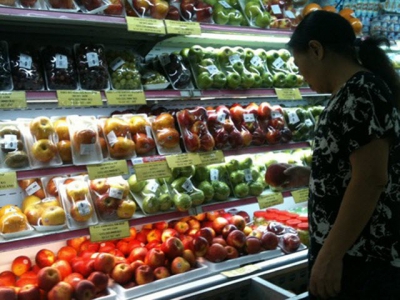Việt Nam spends $1.43 billion on vegetables and fruits import

Foreign fruits imported into Việt Nam are mainly bonbon, mangosteen, apple, jackfruit, orange, pear, kiwi and cherry. — VNA/VNS Photo Hữu Vinh
HÀ NỘI — Việt Nam imported fruit and vegetables worth US$1.43 billion in the first 10 months of this year, a year-on-year increase of 13.1 per cent, according to statistics of the Ministry of Agriculture and Rural Development (MARD).
Thailand was the largest import market, accounting for 43.3 per cent of the total value, followed by China with 23.1 per cent, and the remainder mostly from Australia, South Korea and the US.
Many economic experts have spoken out against the increasing amount of imported fruit and vegetables in Việt Nam, as the country is an agricultural country growing many of its own fruit and vegetables. However, in the past two years, enterprises have imported many kinds of vegetables from foreign countries, directly competing with domestic products.
From average import value of $200 million per year in the past, it now stands at $1.43 billion. It’s predicted that Việt Nam will spend $1.7 billion on importing vegetables and fruits this year.
According to Hoàng Trung, head of the MARD’s Plant Protection Department, the import of vegetables and fruits is not only for domestic consumption but also for re-export. Most of the re-export items are mangosteen, durian, mango and longan imported from Thailand then exported to China in large quantities.
“With import tax of zero per cent in the ASEAN, the temporary import of Thailand fruits and then re-export to China is rapidly increasing,” said Trung.
In term of exports, the country was estimated to earn $3.3 billion from the exports of vegetables and fruits in January-October, up 15.5 per cent compared with the same period last year. China is the largest export market of Việt Nam.
“Việt Nam exported many fruits and vegetables to the world market, which were welcomed by many markets such as the EU, Australia, US, Japan and Russia. On the contrary, it also opened to receiving goods from abroad, implementing free trade agreements strictly,” said Trung.
Có thể bạn quan tâm
 Vietnam shifts to export high-quality rice
Vietnam shifts to export high-quality rice Vietnam is trying to re-position itself as an exporter of high-quality rice instead of low-quality white rice.
 Vietnam rice brand logo will be announced in December
Vietnam rice brand logo will be announced in December The festival would be attended by central ministries; provinces and cities throughout the country; scientists, gardeners, creative farmers, rice farmers
 Improving quality of Binh Duong’s agriculture - Part 1
Improving quality of Binh Duong’s agriculture - Part 1 Under provincial Party Committee’s Program No.26 on the shift of the local agricultural structure towards hi-tech and urban agricultural models